With the plethora of options available in the market, making the right choice for the best HR software can be a daunting task. Ensure that you pick an HR systems software that aligns with your organization’s objectives and adds significant value to your business.
A well-chosen platform not only improves daily HR operations but also strengthens decision-making and overall workforce efficiency.
Table of Contents
- 1. Types of HR Software Solutions
- 2. Must-Have HR Software Features
- 3. Top Benefits of Using HR Software
- 4. Common Challenges in HR Management
- 5. How to Choose the Right HR Software for Your Business?
- 6. Real World Case Study
- 7. Top HR Software Providers in 2025
- 8. Conclusion
- 9. Frequently Asked Questions
Let us understand some important considerations for selecting the best HR software for your organization.
Types of HR Software Solutions
Different types of HR software solutions are available. However, these can be distinguished into three main categories. It is also to be noted that these systems overlap with each other in some areas. The three main types are given below in detail.

1. Human Resource Information System (HRIS)
To begin with, HRIS is the most common and entry-level solution that helps companies manage employee data efficiently. HRIS is mainly about core data management. It simplifies core HR tasks such as onboarding, payroll processing, attendance tracking, compliance alerts, and employee self-service.
HRIS simplifies and automates key tasks such as data input, tracking employee information, and managing core HR functions.
2. Human Capital Management (HCM)
Moving beyond HRIS, HCM offers a complete view of the employee lifecycle at the company, from talent acquisition to management and finally to optimization.
Acquisition involves recruitment and onboarding, management aspect looks at managing day-to-day employees’ work life events, such as tracking attendance and performance reviews. And lastly, optimization is about getting the best out of your employees.
HCM is perfect for companies aiming to foster long-term growth and retention by investing in their people.
3. Human Resource Management System (HRMS)
Lastly, HRMS is the most comprehensive solution that combines both HRIS and HCM functionalities. It largely focuses on the administrative aspects of employee retention. For this purpose, it aims to provide in-depth productivity reports and ensures accurate time tracking. This system is best suited for larger or growing organizations that need to handle diverse HR functions under one integrated platform.
To sum up, while all three systems serve the HR function, each offers different levels of depth and specialization. Hence, choosing the right human resources software for small businesses and large enterprises depends on your company’s size, goals, and how you want to manage your workforce.
Must-Have HR Software Features
It is crucial to understand the key features of HR software when deciding which solution is right for your organization. Below are some important considerations to keep in mind before making your selection.
As businesses increase their investment in HR tools, the global HR tech market is expected to double from $40.45B (2024) to $81.84B (2032), growing at a 9.2% CAGR.
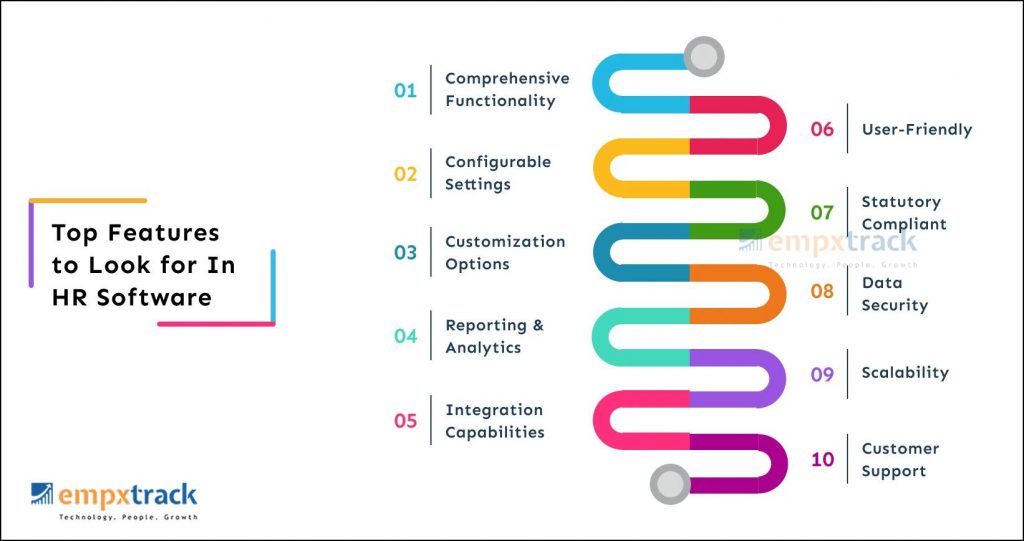
Comprehensive Functionality
An effective HR solution should offer end-to-end functionality that covers every area of human resource management. From recruitment and onboarding to attendance, leave, performance management, payroll, exit, workforce planning, and compliance, it must bring all essential features together in one place.
Ultimately, having all these essential features in one system simplifies HR operations, boosts productivity, and enhances employee experience.
Configurable Settings
Organizations prefer HR vendors that offer configurable software that is aligned with industry standards and the client’s needs. The more configurable a solution is, the greater the chances of using the product for longer.
As an example, an illustration of configurability can be seen in the image below, where all options are being offered to change the process on the fly.

Customization Options
Companies look for solutions that are custom-made to their needs. With customized best HR software applications, each task and workflow can be designed in a specific way to map existing requirements. The biggest advantage of owning personalized HR software is to have the capability to expand as and when your company’s needs evolve, without imparting additional training to the workforce.
A customizable software, such as Empxtrack, is built with a framework to support the specific needs of a customer.
Reporting and Analytics
Data-driven insights are invaluable for strategic decision-making and identifying patterns and trends within the workforce. Look for HR software solutions that offer robust analytics and reporting capabilities, including customizable dashboards and pre-built reports. These provide insights into employee trends, leave trends, and performance trends. Moreover, they also help in analyzing HR metrics such as employee turnover rate, etc.
Integration Capabilities
Varied functions of HR, such as payroll processing, performance appraisal, compensation, leave, benefits, recruitment, etc., are all intertwined. By integrating HR software with other systems, businesses can optimize HR operations, drive efficiency, and achieve better outcomes.
For instance, integrating payroll with time and attendance systems enables automatic synchronization of employee attendance data.
User-Friendly Interface
The best HR systems should have an intuitive, easy-to-navigate interface that promotes usability and efficiency. Pick a top online HR tool that is simple to use.
According to Deloitte research, companies that focus on user experience are more likely to grow faster.
Statutory Complaint
In an environment of constantly evolving laws and regulations, HR plays a pivotal role in ensuring regulatory compliance to mitigate risks. Select software that aligns with compliance requirements and possesses robust capabilities to handle taxation rules specific to the country.
Data Security
Robust security measures, such as encryption, access controls, and regular updates, are essential for protecting sensitive data from unauthorized access or breaches. Thus, it becomes vital to ensure that the chosen HR management system software vendor maintains high security standards.
Quick Implementation
The HR solution must ensure fast implementation and easy deployment, without requiring any extra hardware or infrastructure investment. Regular software upgrades should happen automatically.
Scalability
Your human resource needs today may not match those in a year. Ensure your chosen platform can scale with your company as it grows, whether you’re adding more employees, expanding to new regions, or introducing new HR functions.
Mobile Accessibility
With remote and hybrid work becoming the norm, mobile access is critical. An ideal technology platform should offer a responsive design or mobile app to allow employees and managers to perform essential tasks on the go.
Customer Experience
The HR solution should be built in a way that even non-technical users can navigate it with ease. There should not be a need for additional training to get started. However, to further support users, the platform should also offer 24/7 assistance through email, phone, and chat.
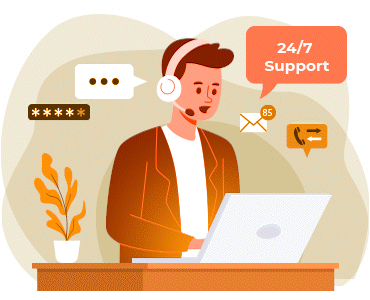
Moreover, it should provide a wide range of self-help resources, including tutorials, user guides, FAQs, and a detailed help center.
Affordability
Affordability is a crucial factor when choosing the right HR software, especially for growing businesses that need powerful tools without overspending. Look for a modern HR solution that offers flexible, budget-friendly options where you only pay for what you need.
Top Benefits of Using HR Software
- Streamlined HR processes
- Instant access to employee data
- Real-time data analytics
- Simplified benefits administration
- Reduced HR queries
- Streamlined recruitment and onboarding
- Enhanced performance management
- Easy compliance management
- Seamless payroll integration
- Better team collaboration
- Empowered employees and managers
- Enhanced efficiency and productivity
- Improved employee engagement and experience
- Significant time and cost savings
Common Challenges in HR Management
Let’s explore some of the most common HR challenges and how using a reliable and efficient HR solution can solve them effectively.
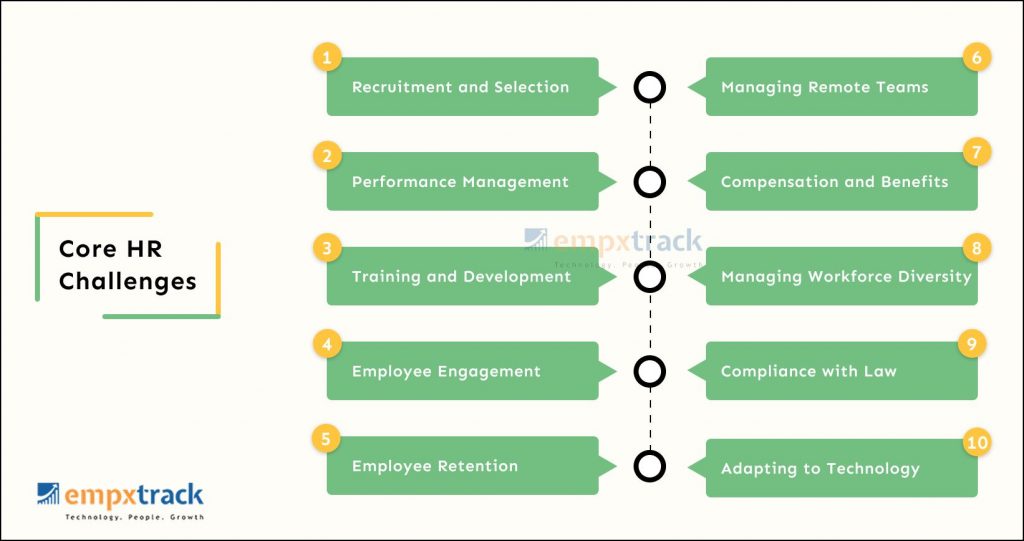
Recruitment and Selection
As technology evolves, the skills needed in the workplace also need to be upgraded. Therefore, using HR software for recruitment and selection of the top candidates can prove to be very helpful. It can help in refining job descriptions, attracting top talent, simplifying interview scheduling and offering onboarding support.
Navigating Workforce Diversity
Managing people from different cultural and personal backgrounds can lead to miscommunication. That’s why team-building activities and open communication are key. To solve this, HR software simplifies managing diverse teams by offering tools that support inclusive communication, transparent feedback, and personalized engagement.
Keeping Employees Engaged
As a company grows, roles, processes, and structures change. As a result, employees may feel disconnected. Therefore, regular updates, open meetings, and feedback sessions help bridge this gap. An efficient workforce management solution supports long-term engagement by streamlining internal communication, enabling regular feedback, and tracking employee sentiment.
Managing Training and Development
Managing training and development is challenging because it demands continuous skill assessments, personalized learning paths, and up-to-date content for a diverse workforce. However, HR software streamlines this process by automating schedules, centralizing resources, and tracking progress in real time.
Performance Management
Performance management is crucial for monitoring and improving employee performance. But it’s a key HR challenge as there are inconsistencies in employee evaluations, a lack of real-time feedback, non-alignment of employee goals to organizational objectives, and time-consuming processes. However, an HR technology tool solves this by automating reviews, setting and tracking goals, and enabling 360-degree feedback.
Managing Compensation and Benefits
Offering fair pay and benefits is critical. Businesses can offer bonuses, recognition programs, or non-cash perks like flexible work hours. These small changes can make a big impact on employee morale and retention. An HR software solution helps to track employee performance, automate bonus calculations, and manage recognition programs efficiently.
Retaining Top Talent
Losing your best employees not only lowers team morale but also leads to significant financial costs and lost productivity during the transition. To retain top talent, it’s important to create a great workplace. Besides, it offers career growth, training, development, and rewards. A structured onboarding plan can also help reduce turnover. In the same manner, HR software helps retain top talent by streamlining onboarding, tracking performance, and supporting career development.
Staying Compliant with Laws
Due to shifting workforce dynamics, employment laws change regularly. Companies thus need to stay updated to avoid legal trouble. Non-compliance can result in audits, fines, or lawsuits. Therefore, it’s crucial to review legal updates and revise policies frequently. In this case, using a human resource management platform can help businesses stay compliant by automating policy updates and tracking regulatory changes.
Managing Remote Teams
Upwork reports that by 2025, approximately 32.6 million Americans will be working remotely, roughly 22% of the U.S. workforce.
The recent shift to remote and hybrid work models has imposed multiple challenges. Some of these include maintaining employee engagement, ensuring effective communication, tracking performance, managing data security, providing consistent training opportunities, and preserving company culture across dispersed teams. However, a cloud-based HR tool centralizes employee data and provides accessible real-time platforms for important tasks like communication, performance tracking, payroll etc.
Adapting to Technology
Many teams face resistance and lack proper tools. As a result, processes slow down. However, software like Empxtrack simplifies this with its easy-to-use features, setup, automation, and real-time updates. This boosts efficiency and reduces manual work.
How to Choose the Right HR Software for Your Business?
HR software comes in all shapes and sizes, catering to businesses of all sizes – from small businesses to large enterprises. When selecting a solution for your small business or a startup, prioritize features like affordability and ease of use. To make the most of your investment, look for the best HR software that offers intuitive functionality, scalability, and essential features tailored for small teams and enterprises.
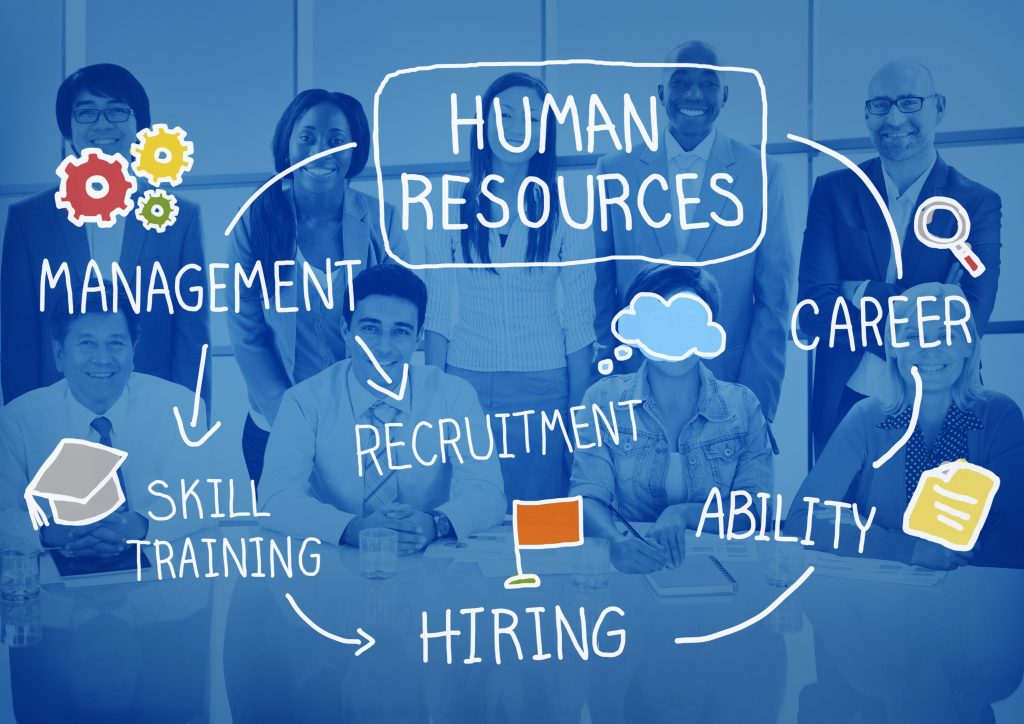
There are some free HR management software options available. These solutions are equipped with basic features required by small teams, startups, and SMBs to manage their essential HR tasks. They help users to start immediately with zero investment. This also reduces costs, motivates teams, and builds a happy work environment.
Moreover, a quick and smooth implementation process and ongoing customer support are crucial for maximizing the value of your investment. From initial setup and configuration to data migration and training, reliable support throughout the implementation phase is vital for a successful transition to the new system.
Real World Case Study
The benefits of introducing performance management software in a manufacturing business can be best understood through the example of Busch LLC, a leading U.S.-based manufacturer offering customized solutions for vacuum applications.
Busch LLC faced several challenges, most of which were directly related to managing employee performance:
- Manual tracking of competencies was time-consuming and prone to errors
- Managers found it difficult to monitor employee goals and progress
- Identifying development needs was a slow and unstructured process
- Performance reviews lacked transparency and consistency
After implementing the Empxtrack performance management system, the company resolved these issues. The platform automated reviews, simplified tracking, and offered real-time visibility into employee progress. Managers could set clear goals and align performance with business objectives.
As shared by Janine Ambrose Salina, Director HR at Busch LLC, “The system turned out to be the perfect solution for our business as we aimed to introduce a more formal and streamlined annual goal-setting and performance evaluation process. It is simple to set up, requires minimal time and effort to administer, and is user-friendly for our employees.”
With the new performance management software in place, Busch LLC improved transparency, empowered employees, and achieved greater efficiency across the organization.
👉 Read the full case study here. Explore the free trial to see how the system can simplify your HR workflows and improve team performance.
Top HR Software Providers in 2025
Following are the popular HR systems that you can use to manage the tasks of your organization with utmost ease and efficiency. Let us have a look at the top software for HR management, their key features, and for which organizations they are best suited:
Empxtrack
Empxtrack is a powerful and flexible cloud-based HR software designed to simplify, automate, and enhance every stage of human resource management, right from onboarding to offboarding. With a range of intuitive features, it helps organizations boost efficiency, improve employee experiences, and stay future-ready. Below are the core features that make Empxtrack a smart choice for any growing business:
Employee Self-Service Portal
Empxtrack empowers employees with a dedicated self-service portal. It allows them to update personal data, view payslips, submit requests, and access HR documents, reducing the administrative burden on HR teams.
Seamless Onboarding
Empxtrack streamlines the onboarding process by organizing all steps in a single, unified platform. It enables HR to send welcome messages, manage documents with e-signatures, and communicate role expectations early. Integrated training support also ensures that new employees are set up for success from day one.
Smart Attendance Tracking
Empxtrack makes attendance tracking effortless with remote check-ins and biometric integration. It also allows organizations to configure attendance policies based on their specific needs.
Timesheets
With this feature, employees can log hours manually or use built-in timers. Timesheets can be submitted for approvals, making it easy to track productivity, monitor project timelines, and bill clients accurately.
Leave Management
Empxtrack simplifies the leave process by allowing you to define various leave types, manage holidays, and track time-offs. It supports multi-location leave policies and streamlines the entire approval workflow.
Seamless Integration
Additionally, the software integrates seamlessly with other HR tools, including payroll systems. By syncing real-time employee data, it automates salary calculations, tax deductions, and ensures complete compliance, saving time and reducing errors. Empxtrack is also integrated with ADP.
Performance Management Made Easy
Empxtrack supports continuous performance tracking through KRAs, goal setting, competency mapping, and 360-degree feedback. It enables detailed performance appraisals and generates insightful reports for better talent decisions.
Customizable Compensation Planning
Managing salaries becomes easier with Empxtrack’s flexible structures, revision tools, and approval processes. Integration with performance reviews allows for transparent and data-backed compensation hikes.
Training and Development
You can design, assign, and assess training programs with ease. The system supports various content formats, tracks progress, and issues completion certificates, ensuring continuous development for all employees.
Advanced HR Analytics
Empxtrack provides rich dashboards and reports on key HR metrics like attrition, attendance, performance, and compensation. These analytics support data-driven decision-making and workforce planning.
Succession Planning
Whether employees change departments or locations, Empxtrack simplifies transitions with role-specific permissions, approval chains, and easy management of transition requests.
Survey and Feedback Tools
Organizations can gather employee opinions through customizable surveys. These tools help measure engagement, collect suggestions, and improve workplace satisfaction.
Mobile Accessibility
Finally, Empxtrack offers a fully functional mobile experience. Employees can mark attendance, apply for leave, view goals, and access training from their mobile phones anytime, anywhere, making HR tasks simpler and more accessible.
Best Suited For:
Organizations of all sizes looking for an affordable, scalable, user-friendly, and highly customizable HR solution that evolves with their business.
👉 Schedule a free demo to see Empxtrack in action. See how we can streamline your HR processes and increase workplace productivity.
Bamboo HR
BambooHR is an online software built to make HR tasks easier and improve the employee experience. It brings all essential functions together in one simple platform.
Key Features:
» Recruitment and onboarding
» Time and attendance tracking
» Performance management
» Payroll and benefits administration
» Employee self-service
» Analytics and reporting
» Easy to use
» Scalable for different business sizes
» Covers a wide range of HR functions
Best Suited For:
Small to large businesses that want a complete HR solution.
Zoho People
Zoho People is a cloud-based HR software that helps organizations manage their workforce efficiently. It focuses on enhancing employee experience. The software achieves this by adapting quickly to business changes and making HR processes more agile and effective.
Key Features:
» Recruitment and applicant tracking
» Onboarding
» Performance management
» Time and attendance and leave tracking
» Payroll (India only)
» Employee self-service and advanced analytics
» Cost-effective for all business sizes
» Scales easily as your company grows
» Offers a comprehensive set of tools
Best Suited For:
Businesses of all sizes looking for an affordable and flexible HR solution.
ADP
ADP offers an all-in-one HR platform that simplifies and automates core HR functions. Designed to support businesses of all sizes, ADP’s solutions enhance efficiency across the employee lifecycle.
Key Features:
» Employee onboarding
» Payroll management
» Benefits administration
» Time & attendance tracking
» Talent management
» Workforce analytics
» Global HR support
» Easy-to-use interface
» Extensive automation capabilities
» Seamless integration with third-party applications
Best Suited For:
Small to medium-sized businesses and larger enterprises seeking a unified HR system that supports growth and operational efficiency.
Oracle HCM Cloud
Oracle HCM Cloud is a robust and comprehensive HR platform, designed to support the entire employee lifecycle from hire to retire. With its extensive suite of features, it enables organizations to drive workforce efficiency, enhance employee engagement, and support global HR strategies.
Key Features:
» Talent management
» Workforce management
» Learning and development
» Compensation and benefits
» Workforce analytics
» Global HR capabilities
» Highly scalable and feature-rich
» Well-suited for complex HR environments
Best Suited For:
Large enterprises that need a powerful, flexible, and scalable HR solution to manage complex global workforces.
Conclusion
While features and functionalities matter, affordability, ease of use, quick implementation, and good customer support are equally crucial. Prioritize these factors when choosing Human Resource management software. HR is an important thread between the employee and the employer and serves as a link between them in a manner that both parties are satisfied. By choosing the best HR software solution, HR can play a more strategic role that empowers employees by allowing them to manage their data and helps retain the best talent in the company.
Liked what you read? Let’s take it to the next level!
Frequently Asked Questions
Q1. | What are the essential features of HR software for SMBs? |
| Ans. | HR software streamlines core functionalities like payroll, benefits administration and time tracking, while offering features like self-service options for employees and adaptable workflows for your unique needs. Advanced HR systems provide extra features like recruitment tools, performance management capabilities, support for learning and development initiatives, and tools for enhancing employee engagement. Look for software with data-driven reporting and a user-friendly interface to empower informed decisions and a happy workforce – all essential for SMB success. |
Q2. | Which is the best HR software for small businesses? |
| Ans. | Empxtrack is the top pick for small businesses in need of software for HR management. It’s ready to use, customizable, and has multiple free offerings. Register and start using the product immediately at absolutely no cost, with no credit card requirements, and add features whenever necessary. Whether you’re a startup or an SMB, Empxtrack has you covered. |
Q3. | How do I choose a new HR system? |
| Ans. | Know your needs: Payroll, benefits, portal, performance? Prioritize features. Budget wisely: Explore options that match your resources. Compare & contrast: Research & compare features from different vendors. Customize for you: Opt for adaptable software that fits your business. Keep it user-friendly: Choose a system easy for everyone to navigate. |
Q4. | Which software is mostly used in the HR department? |
| Ans. | Departments mostly opt for reliable software that has comprehensive functionality, yet affordable, easy to use, and has strong integration capabilities. Empxtrack HR software is being used across the globe by startups, SMBs, and enterprises. It is highly configurable and customizable, accompanied by strong integration capabilities and data security. The software streamlines HR operations effectively by mapping to the existing HR processes of any organization |
Q5. | How much does Empxtrack cost? |
| Ans. | Empxtrack stands out as one of the best HR software options available. It offers both free and enterprise solutions. The free offerings include ready-to-use products for small teams, startups, and SMBs. There are no cost or credit card requirements, and you can start using the product immediately. You have the flexibility to add features as needed and personalize the HR software to your requirements. For larger enterprises, Empxtrack provides highly customizable solutions tailored to existing company processes and future needs. |
Q6. | Is HR software suitable for remote or hybrid teams? |
| Ans. | Yes, it is suitable for remote and hybrid teams. First of all, it simplifies day-to-day HR tasks and reduces manual effort. Moreover, it improves communication across locations by offering centralized access to data. Consequently, teams can collaborate more effectively, no matter where they are. In addition, automation ensures faster task completion and fewer errors. Most importantly, it keeps employees engaged and connected, even in a virtual setup. Therefore, managing a distributed workforce becomes easier, more efficient, and highly productive. |
Q7. | Can HR software be integrated with existing tools? |
| Ans. | Yes, it can be easily integrated with existing tools to enhance workflow and data consistency.. By enabling seamless integration, it ensures that various HR functions work together smoothly. Further, you can easily integrate Empxtrack with other HR and management tools through the Web API. |
Q8. | What does HR software do?? |
| Ans. | HR software simplifies and speeds up everyday HR tasks. In essence, it manages employee information, automates routine work, and creates reports. Meanwhile, cutting down on paperwork and manual effort. This boosts both efficiency and the overall employee experience, especially when using the best HR software. |
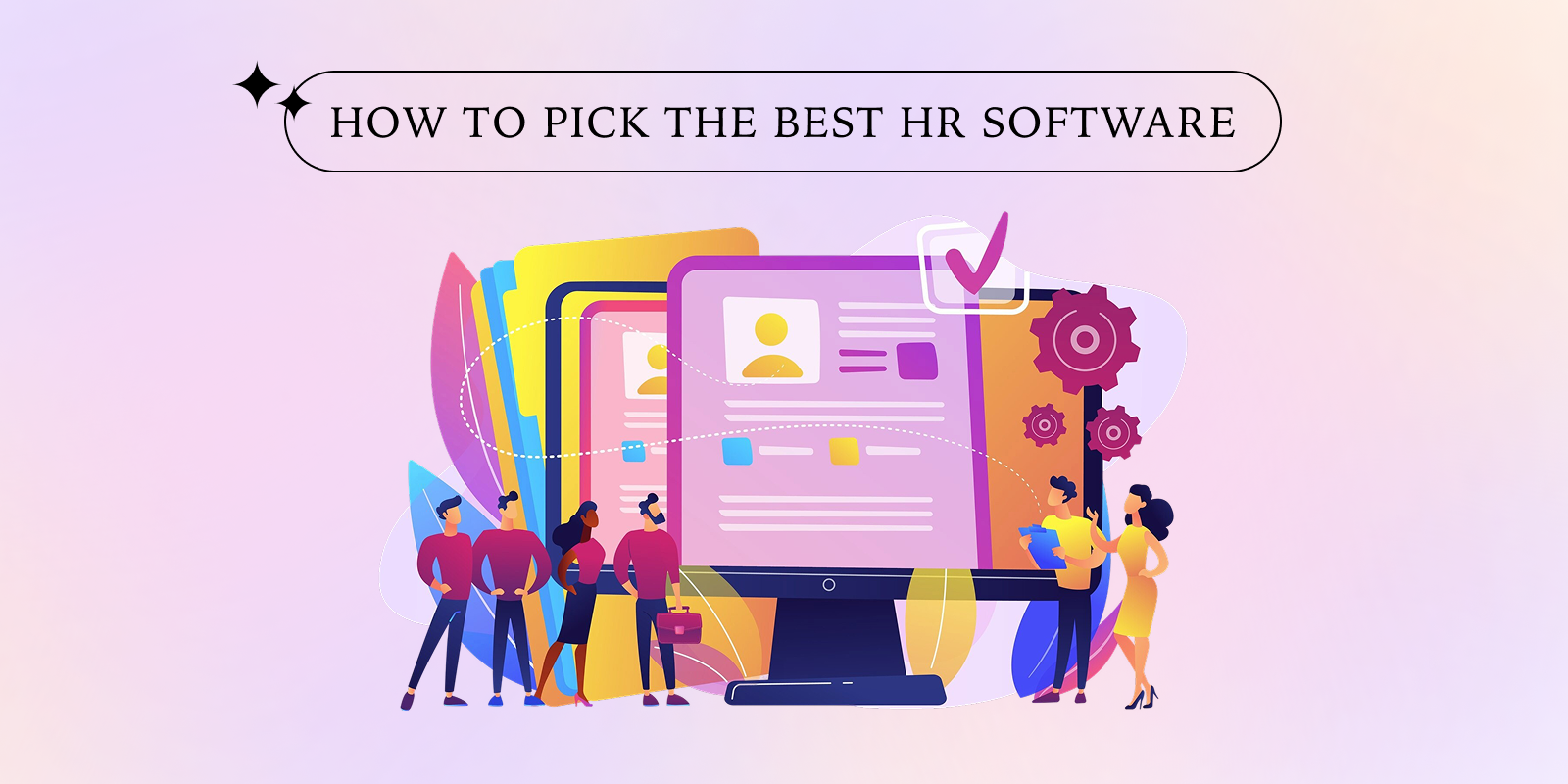



Great insights! Your blog on choosing the best HR software is both informative and well-structured. The breakdown of different software types and key features is particularly helpful. I appreciate how you emphasize data security and usability, which are crucial in today’s work environment. This is a fantastic resource for any business exploring HR technology. Thank you for sharing!
Thanks a lot! We are glad you found the post useful and informative.
As someone new to HR software, I found this article incredibly helpful. The FAQs at the end cleared up many doubts. Looking forward to more content like this!
We are glad the FAQs were helpful. More content like this is on the way!
Really helpful blog. This information can help enterprises choose a good HR software.
Thank you. Glad you found it valuable!
Nice blog. Thanks for sharing such a great information.
Glad you liked it.